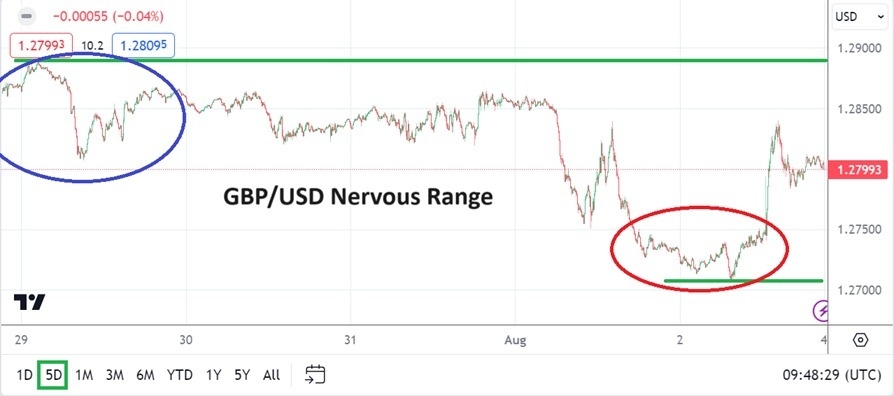The GBP/USD produced a turbulent week of trading and went into this week having regained some value but the currency pair remains under some skeptical eyes.

- The GBP/USD went into the weekend near the 1.27993 level, after touching a low around the 1.27075 earlier on Friday.
- In the final day of trading last week, the GBP/USD managed to deliver a rather accurate definition of existing behavioral sentiment in global Forex and for the British Pound.
- On Wednesday of last week the Fed spoke, on Thursday the BoE acted, and on Friday U.S jobs numbers produced a reminder why financial institutions do not trust central banks.
The ability of the GBP/USD currency pair to touch a low this past Friday which had last been seen on the 3rd of July, and then to reignite higher and finish the week within sight of the important 1.28000 level should be more than intriguing to speculators large and small. The trading in the GBP/USD at the end of last week showed that massive nervousness remains within financial institutions regarding the murky rhetoric they are been given by global central banks. In this case the largest culprit can be said to be the U.S Federal Reserve.
Top Forex Brokers
What the Fed Did and What They Should Have Done
Some might argue that it is merely hindsight which allows someone like me to say the Fed should have sounded more dovish this past Wednesday and actively said they will cut the Federal Funds Rate this coming September and suggest that a November rate cut is being thought about too. However, the Fed remained extremely cautious and spoke about the need to see more data weakness regarding inflation and less strong jobs numbers. Yes, U.S economic data has been declining steadily for a couple of months and jobs numbers have been weaker too during the same time span, but the Fed has wanted to stay quiet.
After the Fed’s cautious rhetoric on Wednesday which frustrated financial institutions which believed the Fed was being too passive, the Bank of England cut its interest rate on Thursday as expected. This was good, but set the table for nervous GBP/USD selling based on the thought interest rates are declining in Great Britain, but seemed to potentially have the ability to remain high in the States.
Poor U.S Jobs Numbers and Buying of the GBP/USD
However, on Friday as the GBP/USD was under strong selling, this as some large players were positioning for potentially stronger than expected U.S jobs numbers, and then Non-Farm Employment Change Number came in much weaker than anticipated. The poor jobs numbers created instant buying in the GBP/USD which started to regain lost ground and the finishing near the 1.28000 level sets the table for an interesting week ahead.
- The weaker jobs numbers in the U.S solidifies the belief the Federal Reserve has been too passive and that the central bank will have to cut the Federal Funds Rate in September by 0.25%.
- Economic data this week from the U.S and U.K will be relatively light, and existing behavioral sentiment will likely lead the GBP/USD in the coming days with the 1.28000 as an important barometer.
GBP/USD Weekly Outlook:
Speculative price range for GBP/USD is 1.27625 to 1.28710
Once again financial institutions may believe the Fed will have to cut rates in September which should act as a brace for the GBP/USD and create some support. The 1.27775 level looks to be oversold territory for the GBP/USD if a bearish trend emerges in the near-term, the 1.27600 level technically appears to be oversold.
Nothing is guaranteed but it appears the GBP/USD may have less danger of suffering a violent decline compared to the ability to create some upwards price momentum. If the 1.28000 ratio can be effectively penetrated and sustained early this week, the currency pair may once again start to challenge marks between the 1.28200 and 1.28600 levels this week. Traders should not be overly ambitious and use proper risk management at all times.
Ready to trade our weekly forecast? Here’s a list of some of the top forex brokers UK to check out.
